The family
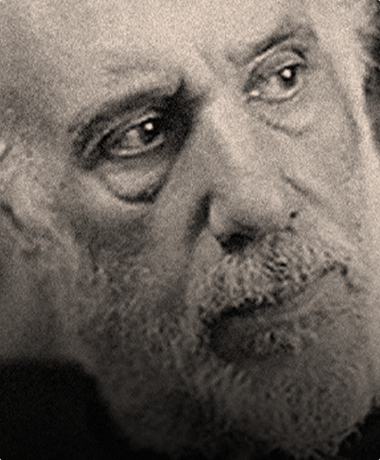
Manos Faltaits
Manos Faltaits
Son of the renowned Greek journalist, author and researcher Kostas Faltaits, Manos Faltaits was born in Athens on 3 January 1983. He was a man with great political, cultural and artistic action and was honored by the Academy of Athens in recognition of his contribution to the preservation of the Greek cultural tradition. He founded the museum in 1964.
Son of the renowned Greek journalist, author and researcher Kostas Faltaits, Manos Faltaits was born in Athens on 3 January 1983.
He studied political science at Panteion University and Law at Aristotle University of Thessaloniki. However, he never practiced Law.
From the very first years as a student, he developed significant political action, by organizing and creating the post-war student movement. During the 1955-1958 period he played a key leadership role as the president of the National Student Union, an association that developed intense action on critical national issues, such as the Cyprus dispute and the Northern Epirus issue. In 1958 he found himself at the first line of the student rallies for the unification of Cyprus with Greece. In 1962 he founded the National Union of Fighting Youths (PEAN) (which had a different action from the PEAN that was founded during the Occupation of 1941), organizing the fights of the young people against globalization.
At the same time, sensing the disastrous impact of globalization on the Greek tradition, he struggled, along with his national and social fights, to preserve and promote our traditional heritage.
In 1963, in cooperation with leading Greek intellectuals he organized the movement for the Greek intellectual regeneration, declaring the year of Pericles Giannopoulos, which was regarded as the greatest intellectual event of that year in Greece. In 1964, at the age of 26, he founded the Faltaits Museum, the first local folklore museum of Greece, to which, he devoted the greater part of his life. For this action, as well as for his valuable contribution to the rescue and preservation of Greek tradition, he was awarded in 1976 by the Academy of Athens.
Starting from 1979, together with his partner in life and struggles, his wife Anastasia, and the support of some close and devoted friends, he organized the movement of Aesthetics Renaissance, inspired by our Ancient, Byzantine and modern traditional heritage.
In parallel, until the end of his life, he developed and he taught, both in Athens and Skyros, at the School of the Road, his theory of "Daismos" and Communalism, the bipolar shape of Harmony and Disharmony, the Universal Soul and Consciousness, as an integrated worldview and biotheory. In 1993, he founded together with Anastasia, the Palaiopyrgos Watchtower in Skyros Theatre and the Festival of the same name, where every summer major cultural events take place.
Manos Faltaits, The Artist and Author
Manos Faltaits developed a rich literary and painting activity, from the 1980s until the end of his life.
He studied painting alongside Dimitrios Pikionis and Fotis Kontoglou. He developed his own artistic movement, which he called "soulvisioning painting" and which, according to Manos, "reveals the soul of the portrayed subjects, whether these are human faces, trees or buildings".
He painted a plethora of paintings and sketches, only few of which are exhibited in the museum, due to inadequate space. He painted his last works in early December 2012 while he was in hospital.
Manos Faltaits also wrote more than 60 historical, folklore, literary, political, philosophical, theatrical and poetic works, while there are still many works that remain unpublished.
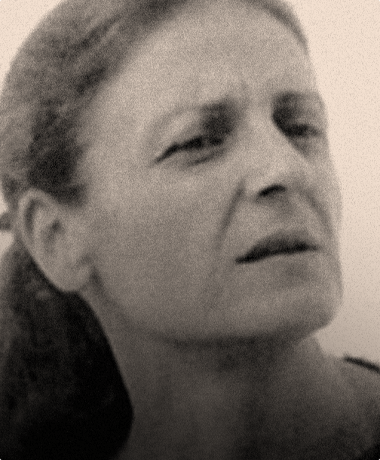
Anastasia Faltaits
Anastasia Faltaits
Anastasia Faltaits was born in Chania in 1938. For many years and until 1979 she taught at the Panteion University at the post of the professor in Political History of modern Greece and published historical essays on modern Greek history.
Anastasia Faltaits was born in Chania in 1938. For many years and until 1979 she taught at the Panteion University at the post of the professor in Political History of modern Greece and published historical essays on modern Greek history.
The following titles are included among her works: 'On Ioannis Kapodistria's naval policies', 'National loans during the 1821 revolution and the mortgage of national land', 'Counselors and Consulates in Skyros during the Turkish occupation', 'The Skyrian sea-fighters Michael and Dimitrios Anestis' etc.
She was the publishing editor of the Historical Documents of the 1821 revolutionary period of Crete Archives and of those regarding the Hellenic palingenesis (Greek Parliament editions).
Her early engagement in literature begun with her first novel 'Chasing my shadow' in 1955.
Between 1960 and 1970 she was considered one of the most important representatives of contemporary female literature.
During that period, she was publishing her articles for the ODIGITIS magazine under the alias 'Markos Evgenikos' and her short stories under her maiden name 'Anastasia Giannoudaki', where 'exceptionally strong emotions emerge', as her reviewers point out.
Her short stories 'If our manly faces' and 'Sorrowful convoys', which illustrated the main issue at that time of youth's immigration, have been very popular and the prominent poet Dialechti Zevgoli - Glezou - in one of her articles on a major daily newspaper in 1963 - recognized her as one of the few new writers that were expected to evolve next-generation's literature.
'The betrayed song' - her best work at that period - has been a chronicle of Greek youth's struggles for the reunion of Cyprus and Greece in which she also actively participated having intense personal experiences.
In 1971 she married Manos Faltaits and thenceforth she was in charge of the management and operation of the Popular and Historical Museum, greatly contributing in its evolution, development and promotion in Greece and abroad.
Her role in the organization of the scientific events of the museum has been valuable and in many domains exclusive thus contributing -with Manos- in the development of the great movement of Greek's cultural rebirth along their Hellenocentric directives that is present until now and carries their signature.
Since 1993 she has organized Skyro's Festival of Viglatoria, Palaiopyrgou and she has been directing Manos Faltaits' theatrical works which are performed by the museum's artistic company called 'Skyretes'.
Her late literature works, are mainly concerned with the intellectual rebirth of Hellinism, inspired by her personal struggles and the important cultural events taking place in Viglatoria, Palaiopyrgos.
There is an intense personal touch in her works which comprise a complicated creation of philosophical and temporal contemplation, of the chronological representation of everyday life and course of the museum and of Viglatoria, Palaiopyrgos, deriving in a valuable chronicle that exerts exceptional charm.
Her most recent work delineates three paths:
The first one is concerned with recording the main historical events during the German occupation and of the Greek civil war (1941 - 1945), as these were intensely and tragically been engraved in her juvenile mentality.
Her published works for this period are the chronicles : 'Zemvragou', 'From Zimvragou to Thesion', 'The end of grandpa Theocharis', 'New year's eve, 1942 only with 2 slices of bonito', 'Roomate Mardochaios'.
This series along the rest of her unpublished work, describe the full 1941-1945 period.
Her second intellectual path is an innovative synthesis of diaries, chronicles, striving and ideological manifests written in poetry and prose, that concern historical settings, social struggles and events of Skyros and the entirety of Greece. Events and settings in which she has actively participated with her actions, her thoughts, her assessments and her talks.
These subjects mainly concern her personal struggles and generally her life attitude.
Her third aspect of her creativity was directed to poetic depictions and comments on the more general social settings of Greece and of the world.
Among them one can find her poem: 'Rebels with a cause', that refers to the destructive events that took place in Athens on December 2008.
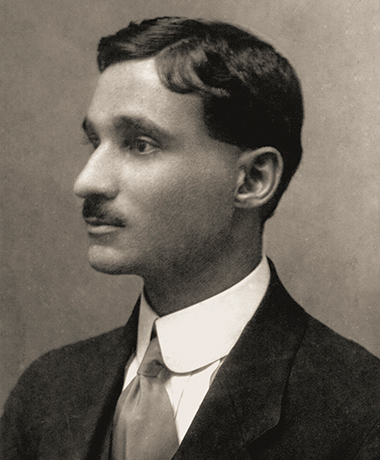
Konstantinos Faltaits
Konstantinos Faltaits
Konstantinos Faltaits, the father of the founder of Faltaits museum, was a prominent journalist, writer and pioneer researcher of the mid-war period (1913 - 1944). He was one of the first members of Journalist's Union of Athens Daily Newspapers and a war correspondent during the Balkan wars and the Asia Minor Campaign and Catastrophe. He is considered a pioneer researcher of Rebetiko and of Roma. He has also contributed for the salvation of Papadiamantis' work - some of whose manuscripts are exhibited in the museum.
Konstantinos Faltaits, the father of the founder of Faltaits museum, was a prominent journalist, writer and pioneer researcher of the mid-war period (1913 - 1944).
He was born in Smyrni (Ismir) in 1891 and was raised in Skyros. He finished the Varvakeios school in Athens and he continued studying Law and Literature at the University of Athens.
He was proclaimed to Doctor of Philosophy in Law, without ever exercising it since it was journalism that attracted him from a very early age.
He begun his career in journalism in 1910 - at the age of 19 - and continued thid profession until the end of his life in 1944.
He worked in a number of newspapers and magazines like 'Acropolis','Empros','Eleftheros Logos','Athenaiki', 'Parnassos', 'Eleftheros Anthropos', 'Bouketo', 'Naftiki Ellada' et al, publishing articles, folklore, historical and ethnological essays, fiction, novels, poems, translations etc. He signed his works under the names F., K.F., Kostas Faltaits, Danaos, Kostas Markellos, A Hellene.
First and Second Balkan Wars
During the Balkan Wars (1912 and 1913) while serving in the Greek Navy, on various destroyers and the battleship 'Averof', he took part in the naval battles of Ellis and Lemnos as well as the battles at the Hellespont Straits (Dardenelles) and the Aegean Islands.
He was already an editor and reporter for the 'Acropolis' newspaper, published by Vlasis Gabreilidis, where he published his reports on the Greek Navy, thus contributing in building up our Navy's myth.
These reports were published in the form of letters, that he signed as F., K.F., Danaos and were reprinted in 1915 in the 'Acropolis' newspaper.
At the same time he co-operated in the edition of a series of war related books that were published by the 'Acropolis' war library': 'The Anectodes of King George I', 'The Anecdotes of admiral Kountouriotis', 'The Anecdotes of the Greco-Bulgarian War' and 'The Anecdotes of Ioannis Velissariou'.
In 1919 he published the chronicle of the sea battle of Elli, in a book titled "I Navmahia tis Ellis" (The Sea Battle of Elli), for which he was nominated for the Literature Excellence award. Several excerpts of this book where published in many educational books, while the 'Naftiki Ellada' magazine published it sequentially in its entirety.
The Asia Minor campaign
Kostas Faltaits took part in the Asia Minor campaign from April 1921, as a war correspondent for the newspaper 'Embros'. He followed and reported on the battles of the Greek Army in Avgin, Nicomedeia (Ismit), Proussa (Bursa), Ouzak, Ada Pazar, Eski-Sehyr, Karamousal, Kiutahya and elsewhere.
In August of that same year, while reporting the battle of Sagarios, he was injured during an air strike.
His last correspondence on the Asia Minor campaign came in 1921 from Kiopru Hisar.
Right after his return from the front, in November 1921, he wrote and published the book 'These are the Turks - Narratives from the massacres of Nicomedeia'. That book was translated by the Greek Ministry of Foreign Affairs in French the following year (1922) and was used by the Greek government to advocate Greece's possition at international summits.
Kostas Faltaits and Alexandros Papadiamantis
Although he hadn't met him personally, Kostas Faltaits played a crucial role in Alexandros Papadiamantis' post euphemism, which had almost diminished after his death in 1921.
A random acquaintance with Papadiamantis' sisters almost 10 years after his death, started a series of initiatives from his behalf in order to honor that great writer and to virtually save his three single sisters. After a number of articles Faltaits managed to focus the attention of both journalists and the Greek State, in order to salvage Papadiamantis' works.
It was because of his initiatives that Papadiamantis' bust was erected in Skiathos. An artistic memorial service was held and a large number of Papadiamantis unpublished work was made available. Through his articles, Kostas Faltaits also managed to salvage Papadiamantis' home and transform it in to a museum.
The ...'other' world
Kostas Faltaits is considered a pioneer researcher of Rebetiko and of Roma (Gypsies at that period).
His involvement with Rebetiko started in 1915, when he published his novel 'The other world', which is considerdd the first published record of the word of the Rebetes. Faltaits journalistic research work continued with a multitude of articles concerning the Rebetiko culture. Later on Kostas Faltaits became a composer of Rebetika songs himself -he was self-taught. He wrote lyrics and music that were performed by Stellakis Perpiniadis, Roza Eskenazy, Yiannis Papasideris among others. He signed his musical compositions as either Kostas Faltaits or under the alias of Kostas Roumeliotis.
In 1929 in an article in the 'Bouketo' magazine, he recorded a number of Rebetika couplets, sorting them by subject. This particular article is considered the first systematic recording of Rebetika songs
Faltaits was also one of the first Greek researchers to engage himself with Gypsies, recording among others their relation with folk songs, their geographical distribution in Greece and the names of their various races.
Kostas Faltaits and Skyros
His contribution in the development of his home country, the island of Skyros, was of major importance. As the founder and president of the Skyrian Association (founded in 1922), he contributed in a defining way :
- In the construction of the road from Skyros (the island's capital) to Linaria (today's port) and from Skyros to Treis Boukes, in the connection via sea with Piraeus adn Kimi, and also to the telecommunication linkage of Skyros with Athens and Chalkis.
-In the deployment of a State anti-malaria team in a period when Skyros had already suffered great casualties due to a spanish flu epidemic in 1919,
-In the construction of a new school, the construction of a gym, the founding of the school of herbal dyes and in the attempt to establish a school of Crafts.
- In the re-publishing of the 'Skyros' newspaper
- In the touristic development of the island, by organizing excursions in Skyros and a number of artistic exhibitions in Athens.
- In the establishment of an archaeological and folklore museum in 1930 (it was the first one that was established in Skyros and it was housed where the city hall stands today) and the creation of a historical register but also in the attempts for performing archaeological excavations.
-In organizing a memorial for the British poet Rupert Brooke, who died in Skyros in 1915.
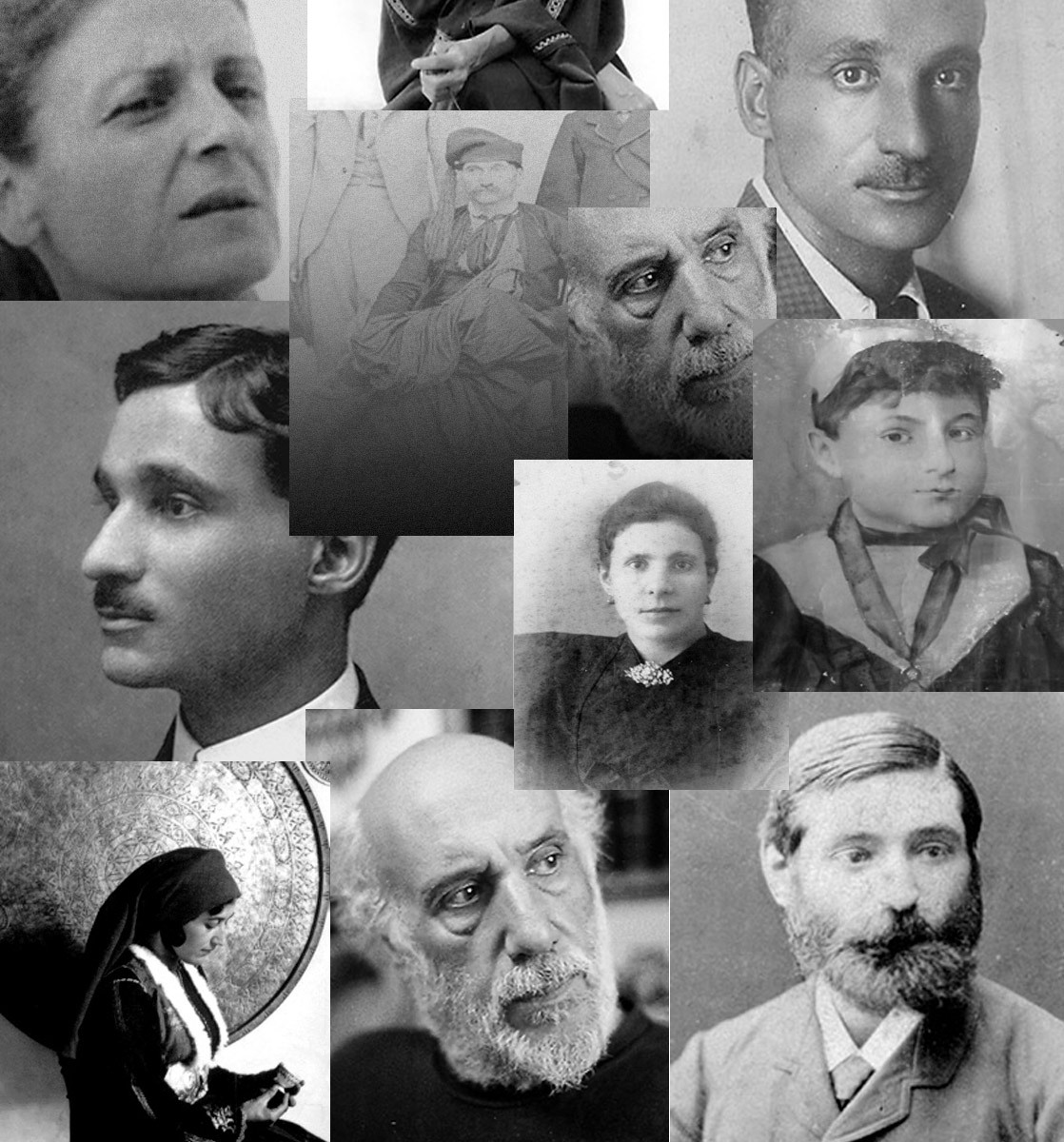
Other family members
Other family members
Georgantis Faltagis, Georgis Grimaldi, Dimitrios Faltaits, Anna, Maria and Ephrosyni Faltaits were some of the people that molded the personality of Manos Faltaits and contributed to the conception and implementation of the idea for creating this museum.
Faltagi Family
An old aristocratic Skyrian family with roots that go beyond the pre-byzantine archaeological era as the surname's etymology suggest.
In essence, the name 'Faltagis' either as a name or surname, is one of the very few Greek names that were salvaged after the domination of Christianity.
The first written reference of the name is found in 1643 when his ancestor Kyparissis Faltagis had been the head of the elders Skyrian delegates that went to Constantinople to regulate the issue of the establishement of the Turkish kadi.
Ever since and until 1821, members of the family have served as elders, secretaries and commissioners of Chora as well as village elders too.
Faltagis Stamatiou
During the critical years of the Kapodistrian period 1828-1831 one of the most dynamic personalities of Skyros was his great-great grandfather of Manos Faltaits, Faltagis Stamatiou.
He has been a dynamic and exuberant personality that delineates the history of the Faltaits' family from the early decades of 19th century, while he had a prominent and leading role in the public affairs of Skyros from the 1821's revolution and thereafter.
During the 1821 revolution he played a defining role as an elder and a keeper of the Castle, protecting Skyrians from the invasions of Liapidon and Pirates.
As harbor master of Skyros he had a significant role too to fighting piracy during the Kapodistria's era.
In 1838 he was appointed as an Attorney in fact of the island towards central administration.
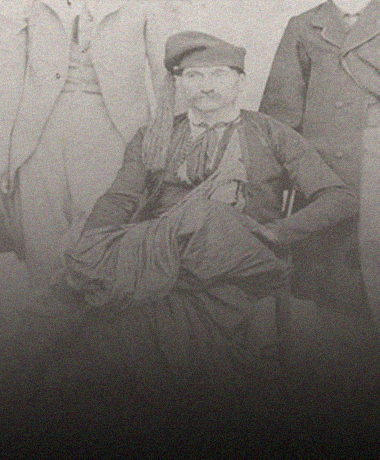
Georgantis Faltagis
He is celebrated among Skyrians who referred to his heroic deeds, as he was a well-known local hero like his father, elder Faltagis.
He took part in the revolution of 1821 - still a teenager - and fought among Karaiskakis' forces in Faliro against Turkish forces of Kioutachi during the Acropolis siege in 1827.
Georgis Grimaldi
The great-grandfather of Anna Faltaits Martselo-Grimaldi, and a close friend, brother in arms and collaborator of Augoustinou Kapodistria.
He played a leading role in the campaign for the liberation of Nafpaktos and of Messologi in 1828 as an immediate collaborator of Augoustinou Kapodistria.
With Augoustino, they saved the relic of the first governor of Greece Ioannis Kapodistrias from the eminent dishonoring of his dead body from his opponents in Nafplio.
Descendant of the hegemonic kin of Grimaldi of Monte Carlo and Genova, from the branch of Grimaldi of Chios.
The Grimaldis came in Chios, after the fall of Constantinoupoli from the Westerns of the 4th crusade in 1204, and belonged to the Maona (edit) of Chios.
The common family emblem of the two branches was the reborn eagle, with open wings, scarlet and golden rhombus.
The ancestors of Zorgi Grimaldi, fought against the Turks in 1453 as collaborating officers of Ioannis Ioustiniani, along with other Genouats of Chios, fighting at Romanos' Gate.
Some relics of George Grimaldi, are kept in Manos and Anastasia Faltaits' museum in Skyros.
His connection with the Viglatoria of Palaiopyrgos can be found from his direct descendancy from the members of Viglatoria of Palaiopyrgos but also from the many relics that are in the museum. Also because his personal stories were a permanent part of the teachings of family members and strongly influenced the formation of their ideological state and their principles.
Grimaldis' sword was a central element of that teaching.
Faltaits G. Dimitrios, Scholar (1855 - 1900)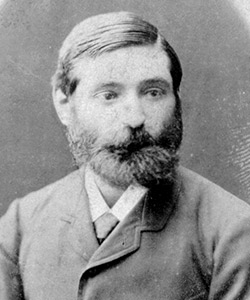
Born and died in Skyros. Married in Smyrni with Anna Martselo - Grimaldi.
He developed an intense social and intellectual presence in Smyrni as well as in Odessa and in Taigarog of Russia, cities where he developed his entrepreneurial activities.
In Taigarog he was closely attached with the eminent poet Achilea Parascho and the famous Russian writer Anton Chekhov and under his suggestion, his close friend Agathoklis Konstantinidis later translated Chekhov's works in the Greek language as well as the works of other famous Russian writers, introducing them to the Greek public.
He wrote the history of Skyros, philosophical essays, memoirs and developed a wealth of philanthropic and social activities along his intellectual one.
He left a lot of unpublished works:
Poems
Essays
Speeches
Teachings
The history of Skyros
Diaries (edit)
Traveling memoirs from Smyrni, Holy lands, Constantinople, Odessa, Trabzon, Mytilini, Chios, Athens etc.
Founder of the Intellectual Fraternity of Smyrni
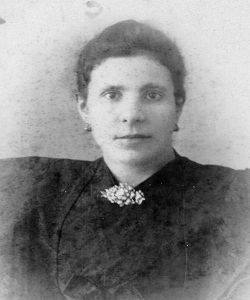 Faltaits Anna
Faltaits Anna
Born and raised in Smyrni, where he married Dimitrios Georganti Faltaits. Daughter of Nikolaos Martselo kai Maria Grimaldi.
In 1893 they moved to Skyros, home of the Faltaits kin.
Mother of Konstantinos Faltaits and Marias Faltaits.
She played a most important role in the intellectual and social life of Skyros until her death in 1944.
Well known are her letters to her son Konstantinos, where she urged him to undertake action for the salvation of
Skyrians from famine that plagued the island due to the British and German-Italian entrenchment of Greece during the 2nd World War.
She decisively influenced in her children teaching them altruism and hyper-consciousness.
A famous event in her life is her night pray in Paleopyrgos, at their home in Skyros, that performed with her four daughters during the winter of 1913, for the salvation of Greek soldiers that fought in Bizani against the cold and the Turks.
She is remembered among Skyrians as the great lady of Paleopyrgos.
Faltaits Maria (1883-1964)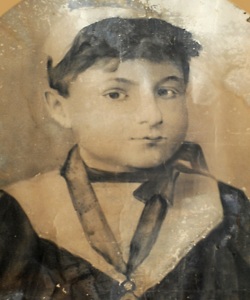
Born in Smyrni in 1883 and died in Skyros in 1964.
Daughter of the scholar Dimitrios Georgandi Faltaits and Anna Martselo of Nikolaos and Marias Grimaldi.
Along her parents moved to Skyros in 1893, the homeland of her father Dimitrios and all of the old aristocratic family of Faltagides to which she belonged.
During her life she developed intense social and intellectual actions and has been one of most prominent intellectual figures of Skyros from the early 20th century to her death in 1964.
She inspired and effectively helped Aggeliki Chatzimichali, a relative from her grandmother's Efrosyni Tzanou side in her famous work 'SKYROS'.
She worked closely with Eve Sikelianou and Aggeliki Chatzimichaly participating actively in the organization of the Delphian festivals, representing the traditions of her island.
She has been - along with her brother Konstantinos - the main organizer of the festival of 'Internal Poetry' that took place in Skyros in 1931 in honor of the English poet Robert Brook and internationally establishes Skyros as the island of Iternal Poetry end the El-Dorado of art.
She invented the great masonry rhythm known in Greece as Skyrian-Vyzantine, that was established in Greece ever since the middle-war times.
She created the 'Skyrian Home' in Skyros' town-hall that is now the island's Archaeological museum.
She contributed - along with her brother Konstantino- in the creation of the archaeological collection of Skyros, that now comprises the core of the local state Archaeological Museum.
She has for many decades been the most prominent intellectual person in the island, playing a leading role in all the social and cultural activities of Skyros' residents.
Her fame continues to be alive until today and her name is remembered by the older Skyrians with great respect, admiration and love.
Faltaits Eyfrosyne (1907 - 1986)
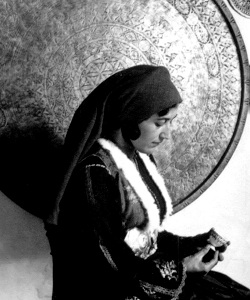 Born and died in Skyros.
Born and died in Skyros.
Daughter of Fragouli Konstantinou Malatesta - Fragouli and of Anna Grigoriadi. Spouse of Konstantinos Faltaits.
Greatly contributed in the organization of the Manos Faltaits' museum with her higher aesthetics and her deep knowledge in traditional culture, popular art and folklore of Skyros.
She donated a large number of relics, embroidery and other valuable artifacts, in the museum and has contributed effectively in the organization of its operations during its first functional years, teaching visitors the culture and the cultural heritage of the island.